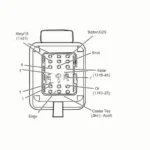The OBD2 error code P0137 indicates a problem with the oxygen sensor circuit low voltage for Bank 1, Sensor 2. This code means that the powertrain control module (PCM) has detected a voltage reading from the oxygen sensor that is lower than the expected range.
But what does that mean for your car? And how can you fix it? This comprehensive guide will delve into everything you need to know about the P0137 code, from its causes and symptoms to diagnostic and repair procedures.
Understanding Oxygen Sensors and the P0137 Code
Before we delve into the specifics of the P0137 code, it’s essential to understand the role of oxygen sensors in your vehicle. These small, but vital components are located in the exhaust system and measure the amount of oxygen in the exhaust gases. This information is then relayed to the PCM, which uses it to adjust the air-fuel mixture for optimal engine performance and emissions control.
The P0137 code specifically refers to the downstream oxygen sensor, also known as Sensor 2. This sensor is located after the catalytic converter and monitors its efficiency. A low voltage reading from this sensor suggests that it’s not detecting enough oxygen in the exhaust stream, which could indicate several underlying issues.
Common Causes of OBD2 Code P0137
The P0137 code can be triggered by various factors, ranging from simple issues like a loose connection to more complex problems with the sensor itself. Here are some of the most common causes:
- Faulty Oxygen Sensor: The most common culprit behind the P0137 code is a malfunctioning oxygen sensor. Over time, the sensor can become contaminated or worn out, leading to inaccurate readings.
- Exhaust Leaks: Leaks in the exhaust system, particularly before the downstream oxygen sensor, can introduce fresh air into the exhaust stream, disrupting the sensor’s readings.
- Wiring Issues: Damaged, corroded, or loose wiring and connectors in the oxygen sensor circuit can disrupt the voltage signal, triggering the code.
- Vacuum Leaks: While less common, vacuum leaks in the engine can affect the air-fuel mixture, indirectly impacting the oxygen sensor readings.
- Faulty PCM: In rare cases, a malfunctioning PCM can misinterpret the oxygen sensor signals, leading to a false P0137 code.
Symptoms of a P0137 Code
While the check engine light illuminating on your dashboard is the most apparent symptom of a P0137 code, other symptoms may accompany it, such as:
- Decreased Fuel Economy: An incorrect air-fuel mixture due to faulty oxygen sensor readings can lead to reduced fuel efficiency.
- Engine Performance Issues: You may experience rough idling, hesitation during acceleration, or a lack of power due to the engine not receiving the optimal air-fuel mixture.
- Failed Emissions Test: A faulty downstream oxygen sensor can cause your vehicle to fail an emissions test.
Diagnosing and Fixing the P0137 Code
Diagnosing the underlying cause of the P0137 code requires a systematic approach. Here’s a step-by-step guide to help you troubleshoot the issue:
- Read the Code: Start by connecting an OBD2 scanner to your vehicle’s diagnostic port and reading the stored codes.
- Inspect the Oxygen Sensor: Visually inspect the downstream oxygen sensor (Bank 1, Sensor 2) for any signs of damage, contamination, or loose connections. Pay attention to the wiring harness and connector as well.
- Check for Exhaust Leaks: Inspect the exhaust system for any leaks, particularly in the area before the downstream oxygen sensor.
- Test the Sensor Voltage: Use a multimeter to test the voltage signal from the oxygen sensor. Refer to your vehicle’s repair manual for specific voltage specifications.
- Inspect the Wiring Harness: Thoroughly check the wiring harness for any breaks, fraying, or corrosion. Ensure all connections are secure.
- Consider Professional Diagnosis: If the issue persists after these steps, it’s recommended to consult a qualified mechanic for further diagnosis and repair.
The repair for the P0137 code will depend on the underlying cause. If the oxygen sensor is faulty, it will need to be replaced. Wiring issues require repairing or replacing the affected components. Exhaust leaks need to be addressed by a qualified mechanic.
Frequently Asked Questions about OBD2 Code P0137
Can I still drive my car with a P0137 code?
While you can still drive your car with a P0137 code, it’s not recommended to do so for extended periods. Driving with a faulty oxygen sensor can lead to decreased fuel economy, engine performance issues, and potential damage to the catalytic converter.
How much does it cost to fix the P0137 code?
The cost of fixing the P0137 code can vary depending on the underlying cause and labor costs in your area. Replacing a faulty oxygen sensor can range from $100 to $300, while repairing wiring issues or fixing exhaust leaks can be more expensive.
How can I prevent the P0137 code from recurring?
Regular vehicle maintenance, including timely oxygen sensor replacements and inspections of the exhaust system, can help prevent the P0137 code from recurring.
Can using the wrong type of fuel cause a P0137 code?
While using the wrong type of fuel is unlikely to directly cause a P0137 code, it can negatively impact engine performance and potentially affect oxygen sensor readings.
Is it safe to clear the P0137 code myself?
You can clear the P0137 code yourself using an OBD2 scanner. However, keep in mind that this will only temporarily clear the code and the check engine light. The underlying problem will need to be addressed to prevent the code from returning.
Seeking Further Assistance with OBD2 Codes?
For additional information and resources on OBD2 codes, including specific vehicle models and error code troubleshooting, visit our related pages:
Remember, a properly functioning oxygen sensor is crucial for optimal engine performance, fuel efficiency, and emissions control. Addressing the P0137 code promptly will ensure your vehicle runs smoothly and efficiently while minimizing the risk of further damage.


